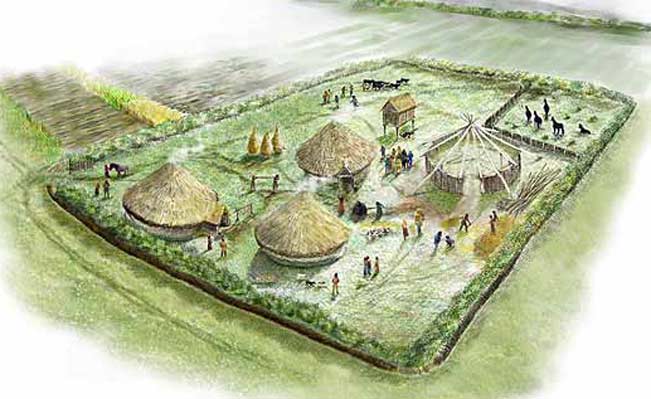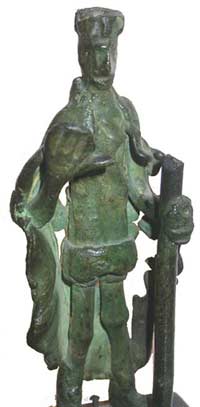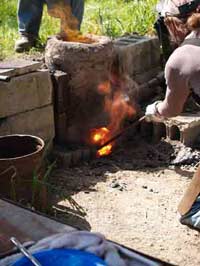
An Iron Age farm
Neil Faulkner Archive | ETOL Main Page
Marxist History
Published online by Counterfire, 23 August 2010.
Copied with thanks from the Counterfire Website.
Marked up by Einde O’Callaghan for the Encyclopaedia of Trotskyism On-Line (ETOL).
The constant rise and fall of Bronze age societies was a product of their wasteful, crisis ridden nature. But in the barbarian periphery around 1300 BCE an industrial revolution had begun that was to transform the world.

An Iron Age farm |
Many revolutions occur on the periphery rather than at the core of global systems. Life on the periphery is less secure, less entrenched, and therefore less conservative.
Manual labour was exploited and despised in the old imperial civilisations of the Bronze Age. Huge surpluses were extorted and wasted on war, monuments, and luxury. There was little left for investment in new technology.
For established elites, innovation was, in any case, dangerous. It involved thought, questioning, the imagining of new possibilities. So human creativity was not only denied the material resources on which to work; it was also drugged by the spells and mysticism of priests.
The occasional spark of ingenuity stands out against a backcloth of stagnation. The Egyptians invented glass-working, the Babylonians accounting, and the Phoenicians the alphabet. The exceptions to the rule are revealing: a luxury commodity, a way of measuring wealth, and a script for recording it. Such inventions are of little use to the farmer or the artisan. They concern the consumption and control of wealth, not its production. They reflect a society in which learning and labour had become separate.
Not so in the barbarian periphery. Here, around 1300 BCE (before the common era), an industrial revolution had begun that was to transform the world.
The archaeological record is unequivocal: from this time onwards, the quantity, range, and sophistication of metal objects exploded. Mining technology advanced to provide an increased supply of copper, tin, and gold. Methods of smelting improved. And the metal-smiths began to use multiple-moulds and the ‘lost-wax’ technique to fashion objects of unprecedented complexity.

Bronze figurine |
Soon, something yet more momentous was happening: metal-workers were experimenting with ways of extracting iron from its stubbornly intractable ores.
Iron was not new. For centuries, crude implements of wrought iron had occasionally been used. But no technique had been developed for the mass production of quality ironwork at an economical cost.
This may have been the achievement of a barbarian tribe living in the Caucasus mountains in remote antiquity. The new technology seems to have spread from there to the Hittite Empire of Anatolia (Turkey). Its further spread was then delayed by the efforts of the imperial ruling class to monopolise iron weaponry.
Because of this, iron artefacts did not become widespread until after 1200 BCE. Iron-working took off amid the collapse of the Bronze Age empires. As it did so, the greatest advances in technique, productivity, and output were registered on the periphery and in the interstices of the great powers.
Iron-working set off a chain of economic, social, and political changes. Bronze was expensive and relatively soft. Because of this, most Bronze Age farmers worked with tools of wood and stone, not bronze. Iron is abundant, cheap, and hard. The barrier to its use had been its high melting-point.
Smelting required specialised bloomeries – furnaces in which bellows were used to force air through a mix of iron ore and charcoal to achieve very high temperatures. Once the technique had been devised, ordinary farmers could build their own backyard bloomeries and re-equip with metal tools.
Anyone who doubts the increase in productivity made possible by iron should try digging the ground with a wooden spade or chopping wood with a stone axe. Three thousand years ago, iron revolutionised agriculture, industry, and war. Its impact was as transformative as that of steam-power in the 19th century.
It also threatened to turn the social world upside down. Bronze was aristocratic. The Bronze Age world was dominated by chariot-mounted warlords equipped with expensive arms and armour. They were supported by peasant masses bound to ceaseless toil with primitive tools.

Reconstruction of traditional |
Iron was the supreme chopper and cutter. Men with iron axes could clear thick forests and jungles to create new farms. Then, with iron ploughs, they could till heavy clay soils. Iron technology unleashed a new wave of agricultural pioneers and free peasants.
Iron was also democratic. The bronzesmiths worked for the palaces, the blacksmiths for the villages.
Iron gave the common man a spear and a sword. And if he stood shoulder-to-shoulder with other such men – if he formed a phalanx – he could stop a chariot charge. And if he could do that, he could kill the landlord. The iron-workers of 1000 BCE, did they but know it, were smelting revolution.
In the free air where numerous petty-chieftains ruled, moving from settlement to settlement, trading his wares and his skills, the metal-smith of the Early Iron Age was the unwitting agent of a new world order. Rival chieftains competed for his services, and this raised his economic value, his social standing, and his own valuation of himself and his craft. This, in turn, gave him the rewards, independence, and self-confidence to be an innovator.
Homer captures something of this. The content of The Iliad and The Odyssey spans four centuries. The poems describe events in the 12th century BCE, but, as orally transmitted epics, they achieved their final, written form only in the 8th. Sometimes Homer is describing the Late Bronze Age, sometimes his own Archaic Age.
When he says that ‘a soothsayer, a doctor, a singer, and a craftsman is sure of a welcome everywhere’, he tells us how things were in a post-imperial age, in the ‘Dark Ages’ of the 8th century BCE, in a world of petty-chieftains and itinerant ironsmiths.
The new class of free artisans, first emerging in the barbarian north, had, by Homer’s time, been long-established in the Eastern Mediterranean.
In the 12th century BCE, the Late Bronze Age empires had collapsed, exhausted by military struggle against one another, and broken by resistance from within and attack from without.
The geopolitical system that replaced them was a kaleidoscope of smaller polities – shrunken imperial states like Egypt, mercantile city-states like Ugarit, and barbarian settlements like Palestine.
Iron-working flourished in this new, more open, less top-down world. Cyprus, an island-centre of maritime commerce, pioneered the iron-based industrial revolution of the 12th and 11th centuries BCE in the Eastern Mediterranean.
The old cycle of rise-and-fall, the repeating rhythm of Bronze Age civilisation, was broken. A new technology was creating a new economy, new social relationships, and new political forms. History was carving out fresh channels.
Some of these channels we must now chart – in Persia, in India, in China, and above all in the Mediterranean.
Neil Faulkner Archive | ETOL Main Page
Eleven Reasons to Fight
Last updated on: 13 February 2022